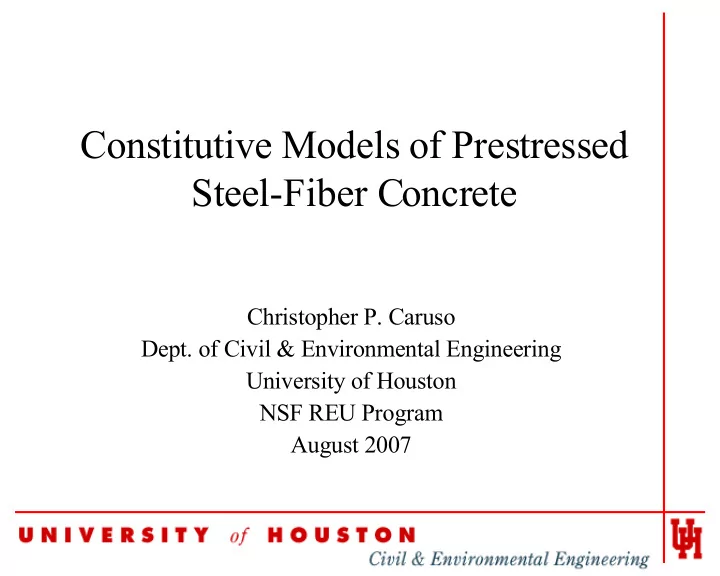

Constitutive Models of Prestressed Steel-Fiber Concrete Christopher P. Caruso Dept. of Civil & Environmental Engineering University of Houston NSF REU Program August 2007
Outline of Presentation • Introduction • Experimental Program • Results • Discussion • Conclusions
Introduction
Purpose • Investigate the behavior of prestressed steel- fiber concrete (PSFC) under shear. – Can steel fibers replace traditional shear stirrups? • Is this a practical and economical improvement? TXDOT sponsored project
Prestressed Concrete • High transverse load-bearing capacity – Initial compressive stress • Used commonly in highway bridge girders. − − − + +
Steel Fiber Concrete • Concrete with short steel wires mixed in. • Known to reduce crack propagation – Absorb energy released when a crack opens Energy Crack Without Steel Fibers P P Energy With Steel Fig. 3 . Cracked Concrete Fibers Panel under a tensile load P .
Constitutive Models • Relate Stress and Strain in a material. – Eg. Prestressed Concrete • Must be determined experimentally. • Can be used to analyze indeterminate structures – Consider with force equilibrium and strain compatibility Sometimes referred to as “Stress-Strain Curve”
Research Significance • Earthquake load simulation • Hollow Bridge Piers subjected to reverse cyclic loading (Yeh and Mo 1999) – Full-scale shake-table test Universal joint Load Cell Cross beam Oil jack 1500 Load Cell Hinge a Actuator 64-#7 j i b Column 900 Reaction 1500 Wall 900 Dial gauge #3@200 300 Cross RC Foundation beam Universal Strong Floor joint 66 168 132 168 132 168 132 168 132 168 66
Research Significance • Constitutive Models N N N 3 3 3 P are used to P P 3 3 3 accurately predict Rigid Beam structure behavior. Nonlinear • Construct a Finite BeamColumn Elements Element Model A A (a) Elevation view
Objective • Investigate Behavior of Prestressed Steel-Fiber Concrete (PSFC). – Construct PSFC panels. – Test panels in sequential loading. • Tension Compression • Record applied loads and panel deformations. – Analyze data. • Determine stress strain curves for concrete and prestressing tendons. – Compare to prestressed concrete panel data.
Experimental Program
Experiment Plan • Fabricate two PSFC panels for testing – TEF1: 0.5 % Steel Fibers by volume. – TEF2: 1.0 % Steel Fibers by volume. • Test panels in Universal Element Tester – Tension – Compression • Collect load & deformation data – Jack Load Sensors – Linear Variable Differential Transformers (LVDT)
Panel Design • Concrete – Type 1 Portland Cement – 6 ksi Compressive Strength – 7 in. Slump • Reinforcement – 10 steel prestressing tendons. – 10 steel compression bars. – Dramix short hook-end steel fibers
t l Unit: mm
t l
Loaded UET Empty UET
Test Procedure • Tensile load to 40 kips • Tensile strain to 1% • Tensile strain to 1.5% • Tensile strain to 2% • Compressive load to 30 kips • Compressive strain to crushing failure
Results
Test Results • TEF1 experienced premature tendon failure – Most tension data was recoverable • TEF2 was not tested due to malfunctioning servo control box – Will be tested once box is repaired • TEF1 data compared to prestressed panel data – Jung Wang, Ph.D student
Experimental Stress vs. Strain
Concrete Stress vs. Strain
Prestressing Tendon Stress vs. Strain
Discussion
Questions • Why did TEF1 experience premature tendon failure? • What do the stress strain curves indicate about the panel’s behavior?
TEF1 Failure • Severe cracks formed at panel boundaries – Disproportionately higher tendon loads during test. • Tendon conduits not fully grouted – Short lengths near panel boundaries experienced unacceptably high strain.
t Severe Tendon Bracket Crack Friction Severe Severe Plate Crack Crack Chuck Prestressing Concrete tendon l Ungrouted Flexible Metal Region Conduit Tendon U- Tendon Bracket Chuck
Conclusions
Conclusions • TEF1 stress-strain curves appear well predicted by prestressed constitutive models. • Despite premature tendon failure, results are promising for success of future tests.
Future Work • Apply maximum compressive load through friction plates • Apply high-strength grout between friction plates and panel • Use tubes to pre-form bolt holes for friction plates
Recommend
More recommend